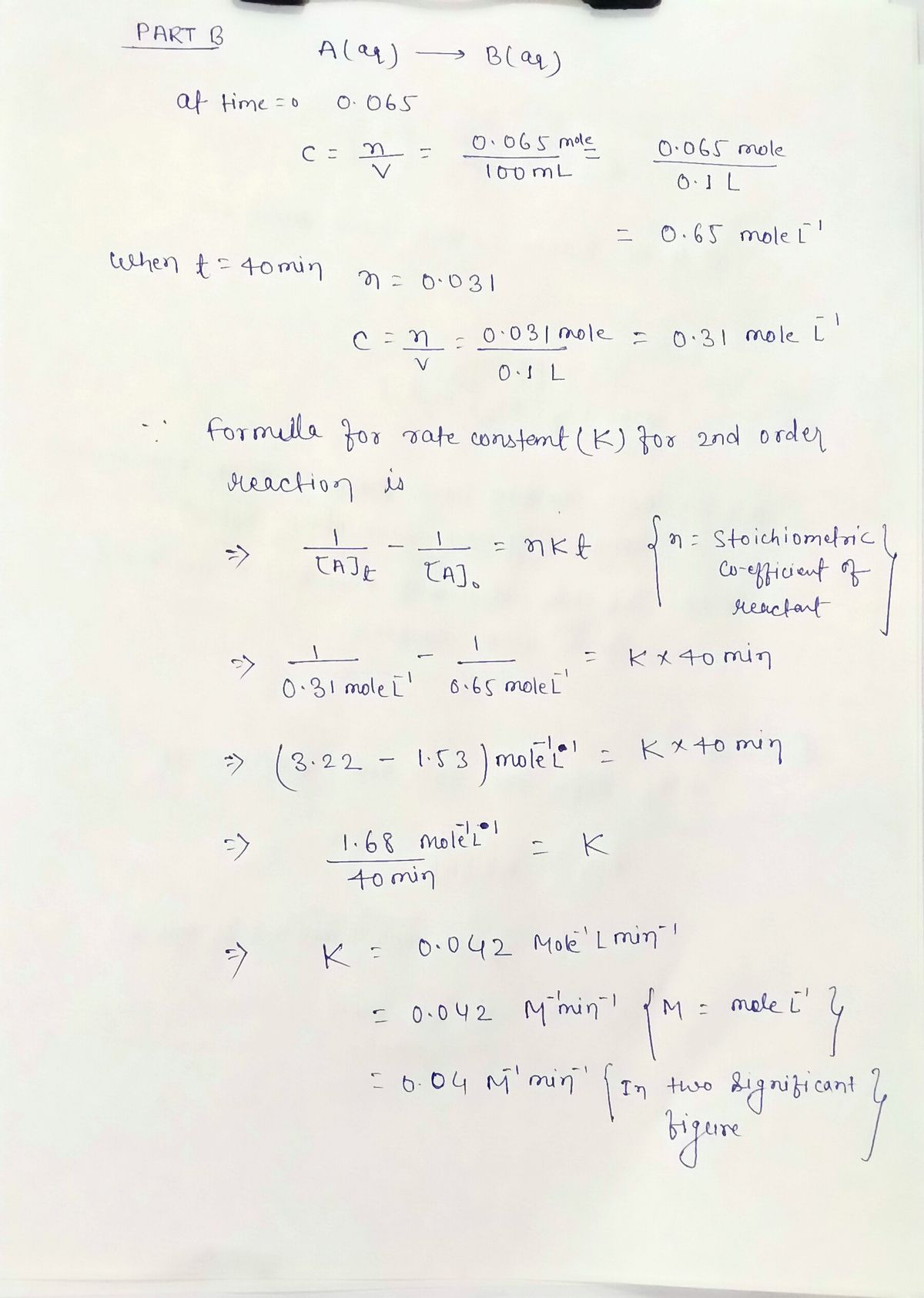Consider the following hypothetical aqueous reaction: A(ag) –→B(ag). A flask is charged with 0.065 mol of A in a total volume of 100.0 mL. The following data are collected: O This is the first order reaction. O This is the second order reaction. Time (min) 0 20 30 10 40 Moles of A 0.065 0.051 0.042 0.036 0.031 Submit Previous Answers v Correct Part B What is the rate constant for the reaction? Express your answer using two significant figures. Πνα ΑΣφ k = 0.419 М min 1 Submit Previous Answers Request Answer X Incorrect; Try Again; 25 attempts remaining Consider the following hypothetical aqueous reaction: A(ag) – B(ag). A flask is charged with 0.065 mol of A in a total volume of 100.0 mL. The k = 0.419 м 1 min 1 following data are collected: Time (min) |0 10 20 30 40 Submit Previous Answers Request Answer Moles of A 0.065 0.051 0.042 0.036 0.031 X Incorrect; Try Again; 25 attempts remaining Part C What is the half-life for the reaction? Express your answer using two significant figures. t/2 = 0.99 min Submit Previous Answers Request Answer X Incorrect; Try Again; 28 attempts remaining P Pearson
Consider the following hypothetical aqueous reaction: A(ag) –→B(ag). A flask is charged with 0.065 mol of A in a total volume of 100.0 mL. The following data are collected: O This is the first order reaction. O This is the second order reaction. Time (min) 0 20 30 10 40 Moles of A 0.065 0.051 0.042 0.036 0.031 Submit Previous Answers v Correct Part B What is the rate constant for the reaction? Express your answer using two significant figures. Πνα ΑΣφ k = 0.419 М min 1 Submit Previous Answers Request Answer X Incorrect; Try Again; 25 attempts remaining Consider the following hypothetical aqueous reaction: A(ag) – B(ag). A flask is charged with 0.065 mol of A in a total volume of 100.0 mL. The k = 0.419 м 1 min 1 following data are collected: Time (min) |0 10 20 30 40 Submit Previous Answers Request Answer Moles of A 0.065 0.051 0.042 0.036 0.031 X Incorrect; Try Again; 25 attempts remaining Part C What is the half-life for the reaction? Express your answer using two significant figures. t/2 = 0.99 min Submit Previous Answers Request Answer X Incorrect; Try Again; 28 attempts remaining P Pearson
Chemistry for Engineering Students
4th Edition
ISBN:9781337398909
Author:Lawrence S. Brown, Tom Holme
Publisher:Lawrence S. Brown, Tom Holme
Chapter11: Chemical Kinetics
Section: Chapter Questions
Problem 11.40PAE: In Exercise 11.39, if the initial concentration of N2Oj is 0.100 .\1. how long will it take for the...
Related questions
Question
part b and c

Transcribed Image Text:Consider the following hypothetical aqueous
reaction: A(ag) –→B(ag). A flask is charged with
0.065 mol of A in a total volume of 100.0 mL. The
following data are collected:
O This is the first order reaction.
O This is the second order reaction.
Time (min) 0
20
30
10
40
Moles of A 0.065 0.051 0.042 0.036 0.031
Submit
Previous Answers
v Correct
Part B
What is the rate constant for the reaction?
Express your answer using two significant figures.
Πνα ΑΣφ
k = 0.419
М min 1
Submit
Previous Answers Request Answer
X Incorrect; Try Again; 25 attempts remaining

Transcribed Image Text:Consider the following hypothetical aqueous
reaction: A(ag) – B(ag). A flask is charged with
0.065 mol of A in a total volume of 100.0 mL. The
k = 0.419
м 1 min 1
following data are collected:
Time (min) |0
10
20
30
40
Submit
Previous Answers Request Answer
Moles of A 0.065 0.051 0.042 0.036 0.031
X Incorrect; Try Again; 25 attempts remaining
Part C
What is the half-life for the reaction?
Express your answer using two significant figures.
t/2 = 0.99
min
Submit
Previous Answers Request Answer
X Incorrect; Try Again; 28 attempts remaining
P Pearson
Expert Solution
Step 1

Trending now
This is a popular solution!
Step by step
Solved in 2 steps with 2 images

Knowledge Booster
Learn more about
Need a deep-dive on the concept behind this application? Look no further. Learn more about this topic, chemistry and related others by exploring similar questions and additional content below.Recommended textbooks for you

Chemistry for Engineering Students
Chemistry
ISBN:
9781337398909
Author:
Lawrence S. Brown, Tom Holme
Publisher:
Cengage Learning

Chemistry: Principles and Reactions
Chemistry
ISBN:
9781305079373
Author:
William L. Masterton, Cecile N. Hurley
Publisher:
Cengage Learning

Chemistry: The Molecular Science
Chemistry
ISBN:
9781285199047
Author:
John W. Moore, Conrad L. Stanitski
Publisher:
Cengage Learning

Chemistry for Engineering Students
Chemistry
ISBN:
9781337398909
Author:
Lawrence S. Brown, Tom Holme
Publisher:
Cengage Learning

Chemistry: Principles and Reactions
Chemistry
ISBN:
9781305079373
Author:
William L. Masterton, Cecile N. Hurley
Publisher:
Cengage Learning

Chemistry: The Molecular Science
Chemistry
ISBN:
9781285199047
Author:
John W. Moore, Conrad L. Stanitski
Publisher:
Cengage Learning

General Chemistry - Standalone book (MindTap Cour…
Chemistry
ISBN:
9781305580343
Author:
Steven D. Gammon, Ebbing, Darrell Ebbing, Steven D., Darrell; Gammon, Darrell Ebbing; Steven D. Gammon, Darrell D.; Gammon, Ebbing; Steven D. Gammon; Darrell
Publisher:
Cengage Learning

Chemistry & Chemical Reactivity
Chemistry
ISBN:
9781337399074
Author:
John C. Kotz, Paul M. Treichel, John Townsend, David Treichel
Publisher:
Cengage Learning

Chemistry & Chemical Reactivity
Chemistry
ISBN:
9781133949640
Author:
John C. Kotz, Paul M. Treichel, John Townsend, David Treichel
Publisher:
Cengage Learning